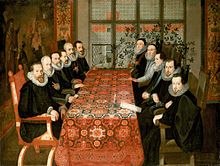| Revision as of 08:57, 10 April 2013 editContaldo80 (talk | contribs)Extended confirmed users15,541 edits Not supported by text← Previous edit | Revision as of 09:56, 10 April 2013 edit undoDragonTiger23 (talk | contribs)3,624 editsNo edit summaryNext edit → | ||
| (One intermediate revision by the same user not shown) | |||
| Line 8: | Line 8: | ||
| On Peraltas' return to Spain, he soon was noted to be a ]. Notable men as the ], ] and ] were frequent targets, as well as more non-notable people. Peralta was once more ordered to withdraw from court in 1618. He returned on the death of ] and was appointed gentleman in waiting to ]'s young wife, ], daughter of ].{{sfn|Fitzmaurice-Kelly|1911}} | On Peraltas' return to Spain, he soon was noted to be a ]. Notable men as the ], ] and ] were frequent targets, as well as more non-notable people. Peralta was once more ordered to withdraw from court in 1618. He returned on the death of ] and was appointed gentleman in waiting to ]'s young wife, ], daughter of ].{{sfn|Fitzmaurice-Kelly|1911}} | ||
| He was a "known homosexual" and this has also been associated with his assasination.<ref>Spanish Writers on Gay and Lesbian Themes: David William Foster, page 12, 1999</ref> | |||
| A fire broke out while Peralta ], ''La Gloria de Niquea'', was being acted before the court on the May 14, 1622, and Peralta carried the queen to a place of safety. Suspicion deepened; Peralta neglected a significant warning that his life was in peril, and "he was murdered as he stepped out of his coach. The responsibility for his death was divided between Philip IV and ]" (at the time, Prime Minister and King's favorite) {{whom?|date=January 2011}}.{{sfn|Fitzmaurice-Kelly|1911}} | A fire broke out while Peralta ], ''La Gloria de Niquea'', was being acted before the court on the May 14, 1622, and Peralta carried the queen to a place of safety. Suspicion deepened; Peralta neglected a significant warning that his life was in peril, and "he was murdered as he stepped out of his coach. The responsibility for his death was divided between Philip IV and ]" (at the time, Prime Minister and King's favorite) {{whom?|date=January 2011}}.{{sfn|Fitzmaurice-Kelly|1911}} | ||
| Line 29: | Line 30: | ||
| ] | ] | ||
| ] | ] | ||
| ] | |||
| ] | |||
| ] | |||
Revision as of 09:56, 10 April 2013
Don Juan de Tassis y Peralta, 2nd Count of Villamediana, (es: Don Juan de Tassis y Peralta, segundo conde de Villamediana; 1582 – 21 August 1622), was a Spanish poet. In Spain he is simply known as Conde de Villamediana.
Life

Peralta was born at Lisbon towards the end of 1582. His father, Juan de Tassis y Acuña, 1st Count of Villamediana, upon whom the title of count was conferred by king Felipe III of Spain in 1603, was a diplomatist heading the Spanish legation who signed the Treaty of London, May 1604.
On leaving Salamanca Peralta married in 1601, and succeeded to the title on the death of his father in 1607; he was prominent in the life of the capital, was forbidden to attend court, and resided in Italy from 1611 to 1617.
On Peraltas' return to Spain, he soon was noted to be a satirist. Notable men as the Francisco Goméz de Sandoval y Rojas, Duke of Lerma, Rodrigo Calderón, Count of Oliva and Jorge de Tobar were frequent targets, as well as more non-notable people. Peralta was once more ordered to withdraw from court in 1618. He returned on the death of Philip III and was appointed gentleman in waiting to Philip IV's young wife, Elisabeth of France, daughter of Henri IV. He was a "known homosexual" and this has also been associated with his assasination.
A fire broke out while Peralta masque, La Gloria de Niquea, was being acted before the court on the May 14, 1622, and Peralta carried the queen to a place of safety. Suspicion deepened; Peralta neglected a significant warning that his life was in peril, and "he was murdered as he stepped out of his coach. The responsibility for his death was divided between Philip IV and Olivares" (at the time, Prime Minister and King's favorite) .
Peralta's works, first published at Saragossa in 1639, contain both his satirical and more serious verses.
References
- ^ Fitzmaurice-Kelly 1911.
- Spanish Writers on Gay and Lesbian Themes: David William Foster, page 12, 1999
- Attribution
- [REDACTED] This article incorporates text from a publication now in the public domain: Fitzmaurice-Kelly, James (1911). "Villamediana, Count de". In Chisholm, Hugh (ed.). Encyclopædia Britannica (11th ed.). Cambridge University Press.
Sources
- Kusche Zettelmeyer, Maria, Juan Pantoja de la Cruz, Madrid, 1964. A hard and successful woman researcher on 16th century painters Italian woman Sofonisba Anguissola, Juan Pantoja de la Cruz and Alonso Sanchez Coello.
- Maria Kusche Zettelmeyer, Juan Pantoja de la Cruz y sus seguidores, Bartolomé González, Rodrigo de Villandrando y Antonio López Polanco . Fundación de Apoyo a la Historia del Arte Hispánico, 2007. ISBN 978-84-935054-2-4